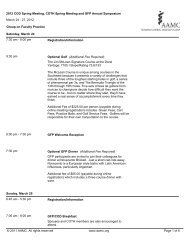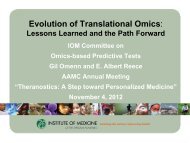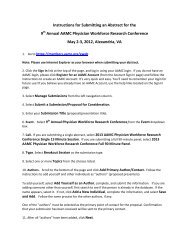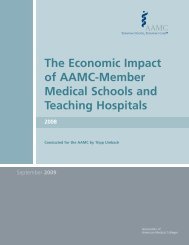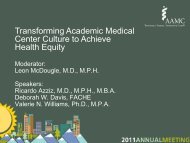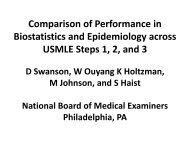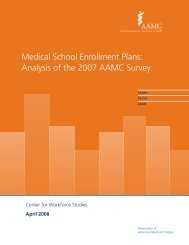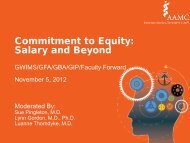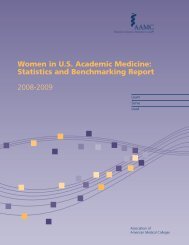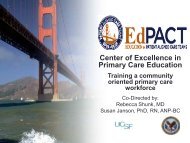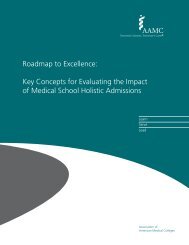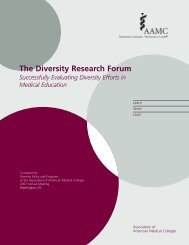Hospitals
Hospitals
Hospitals
You also want an ePaper? Increase the reach of your titles
YUMPU automatically turns print PDFs into web optimized ePapers that Google loves.
State of the Academic<br />
Clinical Enterprise<br />
Highlights from AAMC Data Analyses<br />
Jennifer Faerberg, jfaerberg@aamc.org<br />
Lori Mihalich-Levin, lmlevin@aamc.org<br />
Mary Wheatley, mwheatley@aamc.org<br />
AAMC Health Care Affairs<br />
November 3, 2012
Agenda<br />
• Introduction<br />
• Data Trends for Teaching <strong>Hospitals</strong><br />
• Hospital Margins<br />
• Resident Caps and Counts<br />
• Medicare Payment Analyses<br />
• Readmissions<br />
• Value-Based Purchasing – Medicare Spend Per<br />
Beneficiary<br />
• HOPD E/M Payment<br />
• Payment Bundling<br />
• Upcoming Projects<br />
• Costs of IME<br />
2012 AAMC Annual Meeting
AAMC Health Care Affairs<br />
• Supports the clinical mission of academic<br />
medicine<br />
• Governmental policy, regulatory, operational, and<br />
educational activities affecting clinical care and<br />
graduate medical education (GME) issues<br />
• AAMC constituency groups<br />
• Council of Teaching <strong>Hospitals</strong> and Health Systems<br />
(COTH)<br />
• Group on Faculty Practice (GFP)<br />
• Group on Resident Affairs (GRA)<br />
• Chief Medical Officers Group (CMOG)<br />
• Compliance Officers Forum (COF)<br />
2012 AAMC Annual Meeting
Data Resources<br />
Financial<br />
(revenues,<br />
margins, etc)<br />
Executive<br />
Compensation<br />
Housestaff<br />
Compensation<br />
Quality<br />
Other<br />
Teaching <strong>Hospitals</strong><br />
Operational Financial (OpFin)<br />
Surveys: Annual and<br />
Quarterly<br />
Mercer-IHN Comp Survey<br />
Survey of Resident Fellow<br />
Stipends and Benefits<br />
Hospital Compare Custom<br />
Analyses<br />
Inpatient Impact Analyses<br />
Faculty Practices<br />
GFP Annual<br />
Benchmarking Survey on<br />
practice expenses<br />
Group on Faculty Practice<br />
Executive Compensation<br />
Survey<br />
n/a<br />
n/a<br />
2012 AAMC Annual Meeting
DataTrends: Hospital Margins<br />
2012 AAMC Annual Meeting
Medicare Inpatient Margins, by<br />
Teaching Status, 2000 - 2010<br />
22.9%<br />
21.6%<br />
Major Teaching Other Teaching Non Teaching<br />
19.0%<br />
11.1%<br />
6.0%<br />
9.0%<br />
4.3%<br />
14.2% 12.5%<br />
10.7%<br />
5.0%<br />
1.0%<br />
-1.5% -2.2%<br />
-4.2% -3.9%<br />
-6.5% -6.3%<br />
9.2%<br />
7.4%<br />
5.3%<br />
-3.9% -4.9%<br />
-5.8%<br />
-8.0%<br />
-8.9% -9.4%<br />
6.7% 7.5%<br />
-3.0%<br />
-2.3%<br />
-7.1% -6.4%<br />
2000 2001 2002 2003 2004 2005 2006 2007 2008 2009 2010<br />
Note: Major teaching hospitals are defined by a ratio of interns and residents to beds of 0.25 or greater, while other teaching hospitals have a ratio of greater<br />
than 0 and less than 0.25. A margin is calculated as revenue minus costs, divided by revenue. Data are based on Medicare-allowable costs and exclude<br />
critical access hospitals. Medicare acute inpatient margin includes services covered by the acute care inpatient PPS.<br />
Source: Data for 1997 to 2004 come from MedPAC June 2006 Data Book. All other years’ data come from the June Data Book released two years later<br />
(e.g. Data for 2010 come from the MedPAC June 2012 Data Book).<br />
2012 AAMC Annual Meeting
Hospital Total All-Payer Margins, by<br />
Teaching Status, 2000 – 2010<br />
Major Teaching Other Teaching Non Teaching<br />
4.5%<br />
4.9% 4.7%<br />
4.3% 4.3% 4.4%<br />
2.3%<br />
1.1%<br />
1.3%<br />
5.1%<br />
4.6%<br />
4.9% 4.9%<br />
2.4%<br />
3.0%<br />
6.2%<br />
5.2%<br />
5.2% 5.3%<br />
3.5%<br />
6.8%<br />
5.9%<br />
2.9%<br />
4.5% 5.2% -0.4%<br />
2.2%<br />
4.9%<br />
4.9%<br />
2.4%<br />
6.9%<br />
6.6%<br />
5.3%<br />
2000 2001 2002 2003 2004 2005 2006 2007 2008 2009 2010<br />
Note: Major teaching hospitals are defined by a ratio of interns and residents to beds of 0.25 or greater, while other teaching hospitals have a ratio of greater<br />
than 0 and less than 0.25. A margin is calculated as revenue minus costs, divided by revenue. Total margin includes all patient care services funded by all<br />
payers, plus nonpatient revenue. Analysis excludes critical access hospital.<br />
Source: MedPAC June 2012 Data Book.<br />
2012 AAMC Annual Meeting
The Role of COTH <strong>Hospitals</strong> in<br />
Graduate Medical Education, 2010<br />
COTH <strong>Hospitals</strong> as a Percent of All<br />
Teaching <strong>Hospitals</strong><br />
Residents & Fellows Educated at<br />
COTH and Other Teaching <strong>Hospitals</strong><br />
Other<br />
Teaching<br />
<strong>Hospitals</strong><br />
73%<br />
77%<br />
23%<br />
Note: Data reflect 4,518 short-term, general, non-federal hospitals. Council of Teaching <strong>Hospitals</strong> and Health Systems (COTH) hospitals include 275<br />
integrated and independent members.<br />
Source: AAMC analysis of FY 2010 American Hospital Association Annual Survey data, COTH membership data as of January 2012.<br />
2012 AAMC Annual Meeting
COTH Characteristics<br />
Short-Term, General, Non-Federal<br />
COTH as % of All <strong>Hospitals</strong><br />
<strong>Hospitals</strong> 6%<br />
Admissions 23%<br />
Births 21%<br />
Outpatient Visits 24%<br />
Surgical Operations 22%<br />
Emergency Visits 17%<br />
Neonatal ICU 39%<br />
Pediatric ICU 63%<br />
Burn Units 78%<br />
American College of Surgeons (ACS)-<br />
Verified Level 1 Trauma Centers<br />
82%<br />
Note: Data reflect 4,518 short-term, general, non-federal hospitals. Council of Teaching <strong>Hospitals</strong> and Health Systems (COTH) hospitals include 275<br />
integrated and independent members.<br />
Source: AAMC analysis of FY 2010 American Hospital Association Annual Survey data, COTH membership data as of January 2012, ACS website<br />
2012 AAMC Annual Meeting
COTH Benchmarked Quarterly against Median Teaching Survey Hospital •Twelve Most Results Recent Quarters 2009-2012:<br />
Total Operating Margin<br />
14%<br />
8%<br />
6.70%<br />
2%<br />
4.54%<br />
3.08% 3.39%<br />
5.42%<br />
4.84% 4.54% 4.34%<br />
5.77%<br />
4.49%<br />
4.32%<br />
4.71%<br />
-4%<br />
-10%<br />
2009<br />
Q3<br />
2009<br />
Q4<br />
2010<br />
Q1<br />
2010<br />
Q2<br />
2010<br />
Q3<br />
2010<br />
Q4<br />
2011<br />
Q1<br />
2011<br />
Q2<br />
2011<br />
Q3<br />
2011<br />
Q4<br />
2012<br />
Q1<br />
2012<br />
Q2<br />
Median Teaching Hospital 75th Percentile Teaching Hospital 25th Percentile Teaching Hospital<br />
Source: AAMC•COTH Quarterly Survey of Hospital Operations & Financial Performance<br />
Note: Valid n varies from 138 to 168. Operating Margin = ((Net Patient Service Revenue + Total Other Operating Revenue - Total Operating Expense) / (Net<br />
Patient Service Revenue + Total Other Operating Revenue)) * 100<br />
2012 AAMC Annual Meeting
COTH Quarterly Survey Results 2009-2012:<br />
Total Margin<br />
14%<br />
8%<br />
2%<br />
7.48%<br />
5.50%<br />
5.50%<br />
3.85% 7.29%<br />
6.52% 6.58% 7.07%<br />
2.16%<br />
5.99%<br />
7.22%<br />
5.92%<br />
-4%<br />
-10%<br />
2009<br />
Q3<br />
2009<br />
Q4<br />
2010<br />
Q1<br />
2010<br />
Q2<br />
2010<br />
Q3<br />
2010<br />
Q4<br />
2011<br />
Q1<br />
2011<br />
Q2<br />
2011<br />
Q3<br />
2011<br />
Q4<br />
2012<br />
Q1<br />
2012<br />
Q2<br />
Median Teaching Hospital 75th Percentile Teaching Hospital 25th Percentile Teaching Hospital<br />
Source: AAMC•COTH Quarterly Survey of Hospital Operations & Financial Performance<br />
Note: Valid n varies from 138 to 168. Total Margin = ((Net Patient Service Revenue + Total Other Operating Revenue + Total Non-Operating Revenue - Total<br />
Operating Expense) / (Net Patient Service Revenue + Total Other Operating Revenue + Total Non-Operating Revenue)) * 100<br />
2012 AAMC Annual Meeting
DataTrends: Resident FTE<br />
Cap/Counts<br />
2012 AAMC Annual Meeting
Medicare Resident Limits:<br />
Mandated by the BBA 1997<br />
The number of FTE allopathic and osteopathic<br />
residents<br />
– Limited to 1996 Medicare cost report count<br />
– Limits differ for IME and DGME<br />
– Limit is 130% of 1996 count for rural<br />
hospitals<br />
– Very few exceptions<br />
2012 AAMC Annual Meeting
<strong>Hospitals</strong> Over the DGME Cap, 2010<br />
Total Number of <strong>Hospitals</strong><br />
Over the Cap<br />
Total Number of Resident<br />
FTEs Over the Cap<br />
350 (65%)<br />
Other Teaching<br />
<strong>Hospitals</strong><br />
187 (35%)<br />
Major<br />
Teaching<br />
<strong>Hospitals</strong><br />
6,866 (74%)<br />
Resident FTEs<br />
2,472 (27%)<br />
Resident<br />
FTEs<br />
Source: Medicare Cost Report, FY2010 (August 2012 Release). If they did not have an FY2010 submitted cost report, we took their FY2009 cost report, if available.<br />
Note: <strong>Hospitals</strong> with an FY 2010 are defined as hospitals with fiscal periods beginning between 10/1/2009 and 9/30/2010. <strong>Hospitals</strong> in this analysis only include PPS teaching<br />
hospitals (as determined by the IPPS Final Rule Impact File, FY2013 with an intern and resident-to-bed ratio greater than 0) with a submitted Medicare Cost Report for FY2010<br />
and a DGME Cap and Count. These data reflect results from the resident limit redistribution programs as published at the CMS website. Data from the cost reports are “As<br />
Submitted” and may change upon audit. Major teaching hospitals are defined as having an intern and resident-to-bed ratio greater than or equal to 0.25.<br />
2012 AAMC Annual Meeting
Resident Limit Redistributions<br />
ACA Affected Resident Caps in Two Ways:<br />
• Redistributed 65% of unused slots (Sec. 5503)<br />
• Redistributed all slots from hospitals that closed on or<br />
after 3/23/2008 (and forever into the future!) (Sec.<br />
5506)<br />
2012 AAMC Annual Meeting
Sec. 5506: Redistribution of Slots<br />
from Closed <strong>Hospitals</strong><br />
Redistributes DGME and IME slots from hospitals<br />
that close<br />
• Preference to hospitals located near closed<br />
hospital<br />
• Approximately 1,089 DGME slots and 1,042<br />
IME slots and counting<br />
2012 AAMC Annual Meeting
Sec. 5506 Slots by Teaching Status –<br />
First Round<br />
Number of<br />
<strong>Hospitals</strong><br />
Total Average Median<br />
IME All 57 662.06 11.62 7.62<br />
Major 35 481.16 13.75 8.04<br />
Other 22 180.90 8.22 5.86<br />
COTH 35 437.45 12.50 7.82<br />
DGME All 62 695.27 11.21 7.00<br />
Major 39 497.58 12.76 7.87<br />
Other 23 197.69 8.60 5.67<br />
COTH 41 465.68 11.36 6.76<br />
A total of 88 hospitals applied for DGME/IME Slots:<br />
• 70% received DGME slots<br />
• 65% received IME slots<br />
• 89% of hospitals awarded slots received both IME and DGME slots<br />
COTH accounts for:<br />
• 66% of the IME and 67% of the DGME slots awarded<br />
Note: IME slot increases ranged from 0.01 to 86.06. DGME slot increases ranged from 0.01 to 78.41.<br />
Source: AAMC Analysis of "Section 5506 Cap Increases Related to Applications Due April 1, 2011,” posted 1/30/2012 at<br />
http://www.cms.gov/AcuteInpatientPPS/06_dgme.asp.<br />
2012 AAMC Annual Meeting
Sec. 5506 IME Slots by State –<br />
First Round<br />
238<br />
COTH hospitals in 9 states received IME<br />
slots for a total of 437.45 IME slots.<br />
201<br />
138<br />
135<br />
100<br />
77<br />
61<br />
30<br />
25<br />
25<br />
15 15 13 13<br />
6<br />
0 3 3 1 0<br />
New York Illinois New Jersey Alabama Pennsylvania South<br />
Carolina<br />
Arizona Indiana Connecticut Michigan<br />
All <strong>Hospitals</strong><br />
COTH<br />
Source: AAMC Analysis of "Section 5506 Cap Increases Related to Applications Due April 1, 2011,” posted 1/30/2012 at<br />
http://www.cms.gov/AcuteInpatientPPS/06_dgme.asp.<br />
2012 AAMC Annual Meeting
Sec. 5506 DGME Slots by State –<br />
First Round<br />
All <strong>Hospitals</strong><br />
COTH<br />
Source: AAMC Analysis of "Section 5506 Cap Increases Related to Applications Due April 1, 2011,” posted 1/30/2012 at<br />
http://www.cms.gov/AcuteInpatientPPS/06_dgme.asp.<br />
2012 AAMC Annual Meeting
Top 5 <strong>Hospitals</strong> with Sec. 5506<br />
IME/DGME Slots Awarded – First Round<br />
Hospital Name State IME Slots Awarded IRB ratio<br />
The University of Illinois at Chicago Medical Center* IL 86.06 1.0076<br />
The Mount Sinai Hospital* NY 52.04 0.6516<br />
Richmond University Medical Center NY 34.21 0.3386<br />
Northwestern Memorial Hospital* IL 32.55 0.371<br />
University Of Alabama Hospital* AL 30.47 0.2959<br />
Hospital Name State DGME Slots Awarded IRB ratio<br />
The University of Illinois at Chicago Medical Center* IL 78.41 1.0076<br />
The Mount Sinai Hospital* NY 55.88 0.6516<br />
Northwestern Memorial Hospital* IL 36.76 0.371<br />
Morristown Memorial Hospital* NJ 32.69 0.2444<br />
University Of Alabama Hospital* AL 31.91 0.2959<br />
Note: An asterisk indicates the hospital is a COTH Member as of January 2012.<br />
Source: AAMC Analysis of "Section 5506 Cap Increases Related to Applications Due April 1, 2011,” posted 1/30/2012 at<br />
http://www.cms.gov/AcuteInpatientPPS/06_dgme.asp.<br />
2012 AAMC Annual Meeting
2012 AAMC Annual Meeting<br />
Readmissions
Medicare Readmission Reduction<br />
Program<br />
• Effective FY 2013<br />
• Conditions Measured:<br />
• FY2013-2014 Heart Attack, Heart Failure and Pneumonia<br />
• FY2015 expand to 4 additional conditions (COPD, CABG,<br />
PTCA, Other Vascular)<br />
• Reduction applies to all base DRG payment amounts<br />
(excludes IME, DSH, outliers) in hospitals with excess<br />
readmissions<br />
• “Excess” defined as ratio of actual to expected readmissions<br />
(risk adjusted)<br />
• Reduction is capped at 1%, 2%, and 3% in initial 3 years<br />
2012 AAMC Annual Meeting
Concern with Risk Adjustment<br />
• Risk adjustment is critical when comparing outcomes<br />
across hospitals to ensure adequate and fair<br />
comparisons<br />
• Current risk-adjustment methodology for 30-day<br />
readmissions adjusts for age, gender and a set of comorbidities<br />
for clinical risk (HCCs)<br />
• The risk adjustment does not address socio-economic<br />
status (SES)<br />
• AAMC conducted research to determine if AMCs were<br />
disproportionately impacted by the current riskadjustment<br />
and evaluate alternate approaches<br />
2012 AAMC Annual Meeting
Readmission Rates are Higher for<br />
Major Teaching <strong>Hospitals</strong> (2009)<br />
30-Day Readmission Rates for Teaching and Non-teaching <strong>Hospitals</strong><br />
Source: KNG Analysis of 2009 100% Medicare inpatient file and FY2011 Hospital IPPS final rule impact file.<br />
2012 AAMC Annual Meeting
Readmission Rates are Higher for<br />
Dual Eligibles (2009)<br />
30-Day Readmission Rates for Dual and Non-dual Eligible Beneficiaries<br />
Source: KNG Analysis of 2009 100% Medicare inpatient file and FY2011 Hospital IPPS final rule impact file.<br />
2012 AAMC Annual Meeting
Distribution of <strong>Hospitals</strong> by Percent of Duals:<br />
AMI<br />
Percent of Dual Eligible Patients for AMI<br />
Percent of <strong>Hospitals</strong><br />
0 5 10 15<br />
0 20 40 60 80 100<br />
Percent of Dual Eligible<br />
Source: KNG Health Analysis of 2009 100% Medicare inpatient claims data and 2009 100% denominator file.<br />
Note: Sample includes hospitals with 25 or more admissions for the condition during a hypothetical 3-year period<br />
(i.e. 3 times the number of admissions in 2009).<br />
2012 AAMC Annual Meeting
Approach: Model Specification and<br />
Stratification<br />
Consistent with CMS, we used hierarchical regression model to estimate<br />
the impact of factors on hospital readmissions.<br />
In “blended” model, we estimated separate models for duals and nonduals;<br />
otherwise models were the same as the base model. We<br />
calculated a “composite” risk-standardized readmission rate (RSRR) for<br />
each hospital as follows:<br />
1. (Predicted Readmissions for Duals/Expected Readmission for Duals) * % of Duals<br />
2. (Predicted Readmissions for Non-Duals/Expected for Non-Duals) * % of Non-<br />
Duals<br />
3. Composite RSRR = (1 + 2) * national readmission rate<br />
The composite RSRR was compared to the RSRR from the base model<br />
2012 AAMC Annual Meeting<br />
KNG Health Consulting, LLC<br />
27
Impact of Dual Eligible Model<br />
Distribution of RSRR for AMI<br />
Density<br />
0 .1 .2 .3<br />
Separate models for dual and<br />
non-duals. RSRR = weighted<br />
average of dual and non-dual<br />
predicted over expected<br />
readmission rates multiplied by<br />
the national readmission rate<br />
15 20 25 30<br />
RSRR<br />
Weighted Average of Two Scores<br />
Single Score<br />
Source: KNG Health Analysis of 2009 100% Medicare inpatient claims data and 2009 100% denominator file.<br />
Note: Sample includes hospitals with 25 or more admissions for the condition during a hypothetical 3-year period<br />
(i.e. 3 times the number of admissions in 2009).<br />
2012 AAMC Annual Meeting<br />
KNG Health Consulting, LLC<br />
28
Readmission Program Impact on<br />
COTH Members<br />
48<br />
19%<br />
No Penalty (adjustment=1)<br />
171<br />
69%<br />
29<br />
12%<br />
Max Penalty (adjustment=0.99)<br />
Penalty (adjustment
Readmission Program Average Impact<br />
$100,000<br />
$0<br />
-$100,000<br />
-$200,000<br />
-$300,000<br />
-$400,000<br />
Major Other Non<br />
Teaching Status<br />
Note: Major teaching hospitals are defined by a ratio of interns and residents to beds (from the Impact file) of 0.25 or greater, while<br />
other teaching hospitals have a ratio of greater than 0 and less than 0.25.<br />
Source: AAMC analysis of the FY 2013 IPPS Final Rule Impact and Hospital Readmissions Reduction Program-Supplemental Data<br />
(revised September 2012) files<br />
2012 AAMC Annual Meeting
Value-Based Purchasing (VBP)<br />
• Move from pay-for-reporting to pay-for-performance<br />
• Must meet thresholds based on achievement or<br />
improvement to receive incentive payment<br />
• Phased-in reduction to base DRG payment to fund<br />
incentive pool: 1% for FY2013 increasing by quarter<br />
increments annually up to 2% in FY2017<br />
• Applies to base DRG payment only, does not affect<br />
IME, DSH and outlier payments<br />
• Budget neutral – all funds are returned to hospitals<br />
2012 AAMC Annual Meeting
VBP Average Impact<br />
$6,000<br />
$4,000<br />
$2,000<br />
$0<br />
-$2,000<br />
-$4,000<br />
-$6,000<br />
-$8,000<br />
-$10,000<br />
-$12,000<br />
Major Other Non<br />
Teaching Status<br />
Note: Major teaching hospitals are defined by a ratio of interns and residents to beds (from the Impact file) of 0.25 or greater, while<br />
other teaching hospitals have a ratio of greater than 0 and less than 0.25.<br />
Source: AAMC analysis of the FY 2013 IPPS Final Rule Impact file<br />
2012 AAMC Annual Meeting
How is the VBP Money Moving?<br />
Major, $159M<br />
Other, $322M<br />
Non, $384M<br />
VBP<br />
Incentive<br />
Pool<br />
Major, $156M = 1.7% Loss<br />
Other, $314M = 2.4% Loss<br />
Non, $392M = 2.1% Gain<br />
Note: Major teaching hospitals are defined by a ratio of interns and residents to beds (from the Impact file) of 0.25 or greater, while<br />
other teaching hospitals have a ratio of greater than 0 and less than 0.25.<br />
Source: AAMC analysis of the FY 2013 IPPS Final Rule Impact file<br />
2012 AAMC Annual Meeting
VBP Domains for FYs 2014 - 15<br />
Domain Weighting<br />
FY 2014<br />
Domain Weighting<br />
FY 2015<br />
30%<br />
25%<br />
45%<br />
Process<br />
Outcomes<br />
HCAHPS<br />
20%<br />
30%<br />
20%<br />
30%<br />
Process<br />
Outcomes<br />
HCAHPS<br />
Efficiency<br />
2012 AAMC Annual Meeting
Medicare Spending Per<br />
Beneficiary (MSPB)<br />
• The Affordable Care Act (ACA) states the Secretary<br />
must ensure that efficiency measures are included<br />
in a hospital value-based purchasing program<br />
• The ACA requires the use of Medicare Spending<br />
per Beneficiary measures (MSPB)<br />
• CMS has finalized the inclusion of the MSPB<br />
measure in the VBP program for FY2015<br />
2012 AAMC Annual Meeting
Calculating the Spending Amount<br />
• Based on episodes of care 3 days prior to<br />
admission through 30 days post discharge<br />
• Includes all part A and B services (including outlier<br />
payments)<br />
• Utilizes Medicare Advantage risk-adjustment which<br />
adjusts for age and co-morbid conditions (HCCs)<br />
• Uses standardized pricing<br />
• Scores are calculated based on a hospitals’<br />
average spending across all eligible episodes<br />
compared to the national median<br />
2012 AAMC Annual Meeting
Exclusions<br />
•IME and DSH payments<br />
•Transfers between acute care hospitals<br />
•Patients who died during episode<br />
•Statistical outliers<br />
2012 AAMC Annual Meeting
Determining the Spending Ratio<br />
• Each hospital’s score is ratio<br />
• Ratios are calculated based on a hospitals’ average<br />
spending across all eligible episodes compared to<br />
the national median<br />
• Interpreting scores:<br />
• 1 = Spending is about the same as the national<br />
median<br />
• >1 = Spending is MORE than the national<br />
median<br />
• < 1 = Spending is LESS than the national median<br />
2012 AAMC Annual Meeting
MSPB National Distribution<br />
50%<br />
Medicare Spending Per Beneficiary – All<br />
<strong>Hospitals</strong><br />
Discharges May 2010-February 2011<br />
Percent of <strong>Hospitals</strong><br />
40%<br />
30%<br />
20%<br />
10%<br />
0%<br />
Min 0.32 0.7 0.8 0.9 1 1.1 1.2 1.3<br />
LOWER spend per patient<br />
compared to national median<br />
Ratio<br />
HIGHER spend per patient<br />
compared to national median<br />
Note: N = 3,374 hospitals.<br />
Source: AAMC analysis of Hospital Compare and AAMC member data - April 2012.<br />
2012 AAMC Annual Meeting
COTH Spend Slightly Higher<br />
50%<br />
Percent of hospitals<br />
40%<br />
30%<br />
20%<br />
10%<br />
0%<br />
Min 0.7 0.8 0.9 1 1.1 1.2 1.3 Max<br />
0.75 Ratio<br />
1.14<br />
LOWER spend per patient compared to<br />
national median<br />
HIGHER spend per patient compared to<br />
national median<br />
Note: COTH members (integrated, independent and specialty) n= 260<br />
Source: AAMC analysis of Hospital Compare and AAMC member data - April 2012.<br />
2012 AAMC Annual Meeting
MSPB - Where Spending Occurs<br />
Breakdown by Claim Type (All <strong>Hospitals</strong>)<br />
4%<br />
16%<br />
Home Health Agency<br />
Hospice<br />
59%<br />
15%<br />
1%<br />
Inpatient<br />
Outpatient<br />
Skilled Nursing Facility<br />
Durable Medical Equipment<br />
Carrier<br />
4%<br />
1%<br />
Source: AAMC analysis of the MSPB Spending Breakdowns by Claim Type file, available at<br />
http://hospitalcompare.hhs.gov/Data/spending-per-hospital-patient.aspx<br />
2012 AAMC Annual Meeting
Hospital Outpatient Payments<br />
2012 AAMC Annual Meeting
Physician Payments at HOPD<br />
For many services, Medicare has different<br />
payment rates to physicians based on the site of<br />
service<br />
• “Office” or “Non-Facility”<br />
• Physician payment higher<br />
• Physician responsible for rent, other practice<br />
expenses<br />
• “HOPD” or “Facility” or “Provider-Based”<br />
• Physician payment lower – (fewer expenses)<br />
• Hospital can submit a separate bill for facility costs<br />
• Total payment (physician + hospital) higher<br />
2012 AAMC Annual Meeting
Hospital Outpatient Department<br />
(HOPD) E/M Cuts - MedPAC<br />
January 2012 – MedPAC formally adopted a<br />
recommendation<br />
• “…reduce payments for evaluation and<br />
management office visits provided in outpatient<br />
departments so that total payment rates for<br />
these visits are the same in an outpatient<br />
department for physician office….”<br />
• (MedPAC Report March 2012)<br />
• Phase transition over 3 years<br />
• Limited stop loss for hospitals with DSH patient percent at or above<br />
median (@25%)<br />
• Study by 2015 to examine impact on access for low-income<br />
patients<br />
• Greatest impact on major teaching and nonprofit hospitals<br />
2012 AAMC Annual Meeting
MedPAC Proposal<br />
99213 - Midlevel Established Patient Visit<br />
Fees* Physician Office HOPD Differential<br />
Physician Fee $68.97 $49.27 ($19.70)<br />
Hospital Fee N/A $75.13<br />
$19.70<br />
Total $68.97 $124.40<br />
$68.97<br />
+$75.13<br />
+$19.70<br />
+$55.43<br />
$0<br />
* Fees based on national 2011 rates and include patient copay.<br />
74% reduction to<br />
hospital payment<br />
2012 AAMC Annual Meeting
Impact of E/M Recommendation<br />
Varies across Academic Centers<br />
Millions<br />
$16<br />
$14<br />
$12<br />
$10<br />
Annual Reduction<br />
$8<br />
$6<br />
$4<br />
$2<br />
$0<br />
Impact by Faculty Practice<br />
Source: Analysis of Faculty Practice Solutions Center based on 2010 posted claims<br />
2012 AAMC Annual Meeting
Study<br />
AAMC contracted with The Moran Company to<br />
understand the types of patients served at HOPDs<br />
• Do the patient characteristics differ between<br />
HOPDs and physician offices?<br />
• How do the characteristics differ across<br />
different types of hospital cohorts (DSH Patient<br />
Percentage, teaching status)?<br />
• What is the financial impact?<br />
• Summary data and hospital-specific data<br />
2012 AAMC Annual Meeting
Medicare Claims Data<br />
• 2010 Medicare 5% standard analytic file to<br />
understand visit characteristics<br />
• OPPS 2013 rate setting file to estimate financial<br />
impact to hospitals<br />
2012 AAMC Annual Meeting
Distribution of Medicare E/M<br />
Visits<br />
E/M Visits<br />
Teaching Status<br />
Non 30%<br />
Minor<br />
24%<br />
Office<br />
93%<br />
HOPD 7%<br />
Major<br />
45%<br />
DSH Patient Percent<br />
>=25%<br />
57%<br />
No DPP*<br />
4%<br />
< 11.75%<br />
8%<br />
11.75 - 25%<br />
31%<br />
Source: The Moran Analysis of 2010 5% Medicare Standard Analytic File<br />
2012 AAMC Annual Meeting<br />
*No DPP refers to hospitals<br />
with zero DSH payment or<br />
missing DSH payment data
HOPD Visits Treat Higher Risk Patients and Serve<br />
More Vulnerable Patient Populations<br />
35%<br />
Percent of Hospital E/M Visits<br />
30%<br />
25%<br />
20%<br />
15%<br />
10%<br />
5%<br />
Average Risk<br />
Score/Visit<br />
Office Visit 1.70<br />
HOPD Visit 2.12<br />
0%<br />
Duals Disabled Non-White<br />
Source: The Moran Analysis of 2010 5% Medicare Standard Analytic File; risk score based on HCC model<br />
2012 AAMC Annual Meeting
Major Teaching <strong>Hospitals</strong> Serve<br />
Proportionately More Vulnerable Patients<br />
40%<br />
Percent Hospital E/M Visits by Patient Population<br />
30%<br />
20%<br />
Non-Teaching<br />
Minor Teaching<br />
Major teaching<br />
10%<br />
0%<br />
Duals Disabled Non-White<br />
Source: The Moran Analysis of 2010 5% Medicare Standard Analytic File<br />
2012 AAMC Annual Meeting
Total OPPS Payment Losses for E/M Visits<br />
National* Reduction in OPPS Payments<br />
All hospitals: ~ $1.07 Billion<br />
Teaching <strong>Hospitals</strong>: ~ $740 Million<br />
Major Teaching <strong>Hospitals</strong>: ~ $454 Million<br />
All <strong>Hospitals</strong> with DPP>25%: ~$621 Million<br />
*Excluding MD & PR<br />
Source: The Moran Analysis of OPPS 2013 rate setting file<br />
2012 AAMC Annual Meeting
High Level Findings<br />
• Proposed “equalizations” disproportionately affect<br />
America’s teaching hospitals<br />
• 69% of the total reductions come from teaching<br />
hospitals<br />
• 45% of the total reductions come from major<br />
teaching hospitals<br />
• AAMC members provide disproportionate health care<br />
services to challenging patient populations including<br />
duals, disabled, and “non-white” patients compared to<br />
other hospitals and physician offices<br />
2012 AAMC Annual Meeting
2012 AAMC Annual Meeting<br />
Payment Bundling
What is a bundled payment?<br />
• New payment model where services in a<br />
specified time period are “bundled” together<br />
into a single “payment”<br />
• Payment model is between the extremes<br />
of fee-for-service and full-capitation<br />
• Encourages care coordination across providers<br />
• Beneficiary participation is triggered by an “anchor event”<br />
(i.e., hospital admission).<br />
• Hospital and professional services for the medical<br />
condition over a defined time period are included in the<br />
definition of the episode of care.<br />
55<br />
2012 AAMC Annual Meeting
Two Payment Bundling Initiatives<br />
AAMC<br />
Research<br />
• Research<br />
sponsored by<br />
AHA and AAMC<br />
• Policy<br />
Implications<br />
AAMC<br />
Convener<br />
• Bundled<br />
Payment for<br />
Care<br />
Improvements<br />
• Implementation<br />
56<br />
2012 AAMC Annual Meeting
AHA-AAMC Bundling Analysis<br />
Key Questions:<br />
• How to define a bundle?<br />
• Which conditions? Length of bundle? Which services to<br />
include/exclude?<br />
• How to price a bundle?<br />
• Impact of add-on payments (IME/DSH)<br />
• Risk adjustment, outliers<br />
• How to manage a bundle?<br />
• Understanding the path through a bundle, readmissions<br />
• Other policy considerations?<br />
2012 AAMC Annual Meeting
Data Methodology<br />
• AHA and AAMC contracted with Dobson|DaVanzo to<br />
analyze 5% patient-identifiable Medicare claims data<br />
• Includes functional ability data<br />
• Episodes start with inpatient hospital admission (“index<br />
hospitalization” or “anchor hospital stay”) and end 7,<br />
15, 30, 60 or 90 days following discharge<br />
• Descriptive and multivariate analyses<br />
2012 AAMC Annual Meeting
Defining the Bundle<br />
Characteristics of Clinical Conditions Best Suited<br />
to Payment Bundling<br />
• Adequate prevalence, with sufficient sample size to<br />
predict costs and show the effect of clinical<br />
interventions<br />
• Significant resource consumption for the Medicare<br />
program, either from being expensive on a per-episode<br />
basis or because of high case volume<br />
• Adequate variation in Medicare payment to allow for<br />
efficiency gains, but not so much variation that the risk<br />
of multiple outlier cases outweighs the reward<br />
• Availability of clear, evidence-based clinical care<br />
guidelines<br />
2012 AAMC Annual Meeting
Cardiac and Orthopedic MS-DRGs, Stroke, and<br />
Heart Failure Meet Several Characteristics<br />
Important for Payment Bundling<br />
Prevalent<br />
High Low Evidence-<br />
Select MS-DRG Families by Criteria for<br />
in High Total Average Variance in Based<br />
Payment Bundling*<br />
Medicare Episode Episode Episode Practice<br />
MS-DRG Family<br />
Population Payments Payment Payments Guidelines<br />
Acute ischemic stroke w use of thrombolytic agent (61, 62, 63) x x<br />
Intracranial hemorrhage or cerebral infarction (64, 65, 66) x x x<br />
Nonspecific cva & precerebral occlusion w/o infarct (67,68)<br />
x<br />
Chronic obstructive pulmonary disease (190, 191, 192) x x x<br />
Simple pneumonia & pleurisy (193, 194, 195) x x x<br />
Cardiac valve & oth maj cardiothoracic proc (216, 217, 218,<br />
219, 220, 221)<br />
x x x<br />
Coronary bypass (231, 232, 233, 234, 235, 236) x x x<br />
Perc cardiovasc proc w drug-eluting stent (247) x x x x<br />
Heart failure & shock (291, 292, 293) x x x<br />
Bilateral or multiple major joint procedures of lower extremity<br />
(461, 462)<br />
x x x<br />
Revision of hip or knee replacement (466, 467, 468) x x x<br />
Major joint replacement or reattachment of lower extremity<br />
(469, 470)<br />
x x x x<br />
Hip & femur procedures except major joint (480, 481, 482) x x x x x<br />
*Criteria include prevalence in the Medicare population (>1% of episodes), high total episode payments (>2%<br />
of total payments) or average episode payments (>$20,000), low variance in episode payments (CV
Pricing the Bundle<br />
Add-on payments such as indirect medical<br />
education (IME) and disproportionate share (DSH)<br />
affect the price of bundle<br />
• Including add-ons to the bundle increases<br />
the average bundle price for major teaching<br />
hospital<br />
• Yet excluding add-ons from bundle<br />
calculations does not recognize losses from<br />
reduced readmissions<br />
2012 AAMC Annual Meeting
Pricing the Bundle: Add-On Payments<br />
Increase Bundle Price<br />
Source: Dobson | DaVanzo Analysis, 30-day episodes, 2007-2009 5% Medicare claims<br />
2012 AAMC Annual Meeting
Pricing the Bundle: Add-on Payments<br />
Impact Readmissions<br />
Average Add-On Payments for Readmissions<br />
(30-day Episodes)<br />
Source: Dobson | DaVanzo Analysis, 30-day episodes made from 2007-2009 5% Medicare claims<br />
Add-ons can represent up to 60% of the Base<br />
DRG payment for Major Teaching <strong>Hospitals</strong><br />
2012 AAMC Annual Meeting
Pricing the Bundle: Regression<br />
Methodology<br />
Dobson DaVanzo performed a series of multivariate regression<br />
analyses to simulate a nationwide bundled payment system<br />
• Dependent Variable: Current Medicare allowed payment per<br />
episode (including patient copayments, Indirect Medical Education<br />
[IME], disproportionate share hospital [DSH] payments, and<br />
capital)<br />
• Independent Variables: Beneficiary, facility, and episode<br />
characteristics (e.g. age, sex, chronic conditions, functional ability,<br />
IME, first post-acute care setting after hospital discharge)<br />
Simulated bundled payments are the “predicted” Medicare allowed<br />
payments under the various models for each patient episode<br />
Dobson/DaVanzo then applied an outlier model comparable to the<br />
Inpatient Prospective Payment System (IPPS) outlier policy<br />
2012 AAMC Annual Meeting
Pricing the Bundle: Patient and Hospital<br />
Variables Included in Pricing Model<br />
Naïve Model Model A Model B Model C<br />
MS-DRGs x x x x<br />
Age Variable<br />
x x x<br />
Sex s<br />
x x x<br />
Race Include<br />
x x x<br />
Chronic d in Conditions x x x<br />
HCC Each Count x x x<br />
Functional Episode Ability x x x<br />
Live Paymen Alone x x x<br />
Dual t Model Eligibility x x x<br />
IME x x x<br />
DSH x x x<br />
Index Outlier Payment x x x<br />
Look Back CCU x x<br />
Look Back ICU x x<br />
Episode Death x x<br />
Region x x<br />
Rural x x<br />
Bed Size x x<br />
Unique Physician Count x x<br />
First PAC Setting<br />
x<br />
2012 AAMC Annual Meeting
Pricing the Bundle: Factors that Drive Payment<br />
Bundles<br />
Progression of R 2 Value with Addition of Variables in Model A, Model B, and Model C<br />
All MS-DRGs (Number of Observations = 1,292,352)<br />
Regression Model Variables Cumulative R 2 *<br />
MS-DRG 0.511<br />
Age, Sex, Race 0.514<br />
Chronic Conditions 0.528<br />
Model A<br />
HCC Count 0.534<br />
Functional Ability and Live Alone 0.647<br />
Model B<br />
= Contribution to<br />
Explained Variance<br />
Dual Eligibility 0.647<br />
IME, DSH, Index Outlier Payment 0.669<br />
Look Back CCU, ICU, and Episode Death 0.669<br />
Region 0.669<br />
Rural 0.669<br />
Bed Size 0.670<br />
Unique Physician Count 0.762<br />
Model C First PAC 0.781<br />
Source: Dobson | DaVanzo Analysis, 30-day episodes , 2007-2009 5% Medicare claims, no outlier model applied<br />
* The adjusted-R 2¸ which accounts for degrees of freedom, was nearly identical to the R 2 values presented and follows<br />
the same trend.<br />
<br />
<br />
<br />
<br />
2012 AAMC Annual Meeting
Managing the Bundle: Readmissions<br />
significantly add to cost of episode<br />
Average Medicare Episode Paid by Readmission Status for Select MS-DRGs<br />
(30-Day Episode)<br />
Average Medicare Episode Paid<br />
$35,000<br />
$30,000<br />
$25,000<br />
$20,000<br />
$15,000<br />
$10,000<br />
$5,000<br />
Surgical<br />
Medical<br />
$0<br />
247 470 481 192 194 291<br />
MS-DRG<br />
Episode With a Readmission<br />
Episode Without a Readmission<br />
247: Percutaneous cardiovascular procedure with drug-eluting stent w/ MCC 192: Chronic obstructive pulmonary<br />
disease without CC/MCC<br />
470: Major joint replacement or reattachment of lower extremity w/o MCC 194: Simple pneumonia & pleurisy w CC<br />
481: Hip & femur procedures except major joint w CC 291: Heart failure & shock<br />
w MCC<br />
Source: Dobson | DaVanzo Analysis, 30-day episodes, 2007-2009 5% Medicare claims<br />
67<br />
2012 AAMC Annual Meeting
Managing the Bundle: Percent of Episodes<br />
with a Readmission for Select MS-DRGs by<br />
First Setting (30-Day Episode)<br />
First Setting<br />
Percent of Episodes with a Readmission by MS-DRG<br />
Surgical<br />
Medical<br />
247 470 481 192 194 291<br />
HHA 17.4% 4.0% 6.9% 18.5% 16.8% 24.8%<br />
SNF 29.1% 8.7% 13.6% 21.2% 18.6% 27.7%<br />
IRF * 8.5% 11.5% 23.7% 14.0% 29.2%<br />
LTCH * 6.9% * 18.9% 12.9% 19.7%<br />
Community 7.8% 5.0% 13.1% 12.9% 12.3% 23.1%<br />
Other 12.9% 3.8% 6.8% 17.8% 13.0% 14.8%<br />
Total 11.3% 6.6% 12.6% 17.1% 15.7% 24.2%<br />
247: Percutaneous cardiovascular procedure with drug-eluting stent w/ MCC 192: Chronic obstructive pulmonary<br />
disease without CC/MCC<br />
470: Major joint replacement or reattachment of lower extremity w/o MCC 194: Simple pneumonia & pleurisy w CC<br />
481: Hip & femur procedures except major joint w CC 291: Heart failure & shock<br />
w MCC<br />
Source: Dobson | DaVanzo analysis of research-identifiable 5% SAF for all sites of service, 2007-2009, wage index adjusted<br />
by setting and geographic region, and standardized to 2009 dollars.<br />
* Indicates cell size fewer than 11 observations.<br />
68<br />
2012 AAMC Annual Meeting
Managing the Bundle: Percent of<br />
Readmissions for Select MS-DRGs by<br />
Antecedent Setting (30-Day Episode)<br />
Percent of Readmissions by MS-DRG<br />
Antecedent<br />
Surgical<br />
Medical<br />
Setting<br />
247 470 481 192 194 291<br />
Home Health 4.4% 25.8% 7.9% 13.3% 15.2% 17.4%<br />
SNF 2.3% 38.4% 65.5% 6.4% 20.1% 21.0%<br />
Inpatient Rehab * 8.8% 10.4% 0.4% 0.5% 1.0%<br />
Long-Term Care * * * * 0.3% 0.5%<br />
Community 84.3% 18.3% 9.5% 74.6% 56.9% 52.9%<br />
Other 8.2% 8.3% 5.4% 4.9% 6.9% 7.3%<br />
Total 100.0% 100.0% 100.0% 100.0% 100.0% 100.0%<br />
247: Percutaneous cardiovascular procedure with drug-eluting stent w/ MCC 192: Chronic obstructive pulmonary<br />
disease without CC/MCC<br />
470: Major joint replacement or reattachment of lower extremity w/o MCC 194: Simple pneumonia & pleurisy w CC<br />
481: Hip & femur procedures except major joint w CC 291: Heart failure & shock<br />
w MCC<br />
Source: Dobson | DaVanzo analysis of research-identifiable 5% SAF for all sites of service, 2007-2009, wage index adjusted<br />
by setting and geographic region, and standardized to 2009 dollars.<br />
* Indicates cell size fewer than 11 observations.<br />
69<br />
2012 AAMC Annual Meeting
Managing the Bundle:<br />
Understanding the Patterns<br />
MS-DRG 470:Major joint replacement or reattachment<br />
of lower extremity w/o MCC<br />
Facility-Based<br />
Sequence Stops:<br />
A=STACH (Index or<br />
Readmission)<br />
H=HHA<br />
I=IRF<br />
L=LTCH<br />
S=SNF<br />
Ambulatory-Based<br />
Sequence Stops:<br />
C=Community<br />
(Physician and<br />
Outpatient)<br />
E=ER<br />
P=OP Therapy<br />
T=Hospice<br />
Z=Other IP<br />
Pathway<br />
Number of<br />
Episodes<br />
Percent of<br />
Episodes<br />
Average<br />
Medicare<br />
Episode Paid<br />
A-H-C 236,300 20.7% $14,519<br />
A-S-H-C 116,300 10.2% $20,039<br />
A-S 88,900 7.8% $23,396<br />
A-C 84,220 7.4% $12,078<br />
A-I-H-C 50,460 4.4% $26,925<br />
A-S-C 48,620 4.3% $18,786<br />
A-S-H 44,240 3.9% $21,481<br />
A-H-C-P 34,360 3.0% $14,649<br />
A-H 26,860 2.4% $14,145<br />
A-P-P 24,740 2.2% $12,317<br />
Subtotal 755,000 66.2% $17,575<br />
Other 385,340 33.8% $21,501<br />
Total 1,140,340 100.0% $18,901<br />
Source: Dobson | DaVanzo analysis of research-identifiable 5% SAF for all sites of service, 2007-2009, wage index adjusted by setting and<br />
geographic region, and standardized to 2009 dollars. All episodes have been extrapolated to reflect the universe of Medicare beneficiaries.<br />
Medicare Episode Paid includes care from all facility-based and ambulatory care settings and excludes beneficiary co-payments. IME, DSH,<br />
copay, capital, and other third party have been removed from payments. HH PPS payments do not include payments for Part D drug or DME<br />
services that are provided under SNF, IRF, and LTCH PPS payments.<br />
70<br />
2012 AAMC Annual Meeting
Key Findings<br />
• Bundling is here<br />
• Providers/policy makers need to consider several<br />
factors in designing/implementing bundling program<br />
• Pricing the bundle<br />
• Including beneficiary demographic and clinical<br />
characteristics, as well as add-on payment factors in<br />
risk adjustment better predict price of a bundle<br />
• Managing the Bundle<br />
• Understand how patient moves through bundle<br />
• Readmission trends<br />
Issue Brief and Comprehensive Report at<br />
www.aamc.org/bundling<br />
2012 AAMC Annual Meeting
AAMC as Convener: Bundled<br />
Payments for Care Improvement<br />
2012 AAMC Annual Meeting
Bundled Payments for Care<br />
Improvement Initiative (BPCI)<br />
• Announced in August 2011 by the CMS<br />
Innovations Center (CMMI); option to apply for<br />
four different models of bundled payments<br />
• Included the unique role of “convener” who<br />
applies with partner organizations and provides<br />
technical assistance<br />
• AAMC Partners: Brandeis University for data<br />
analysis and Manatt Health Solutions for project<br />
management<br />
73<br />
2012 AAMC Annual Meeting
Bundled Payment Models<br />
Overview<br />
Episode<br />
Definition<br />
Beneficiary<br />
Inclusion<br />
Criteria<br />
(Reason for<br />
hospitalization<br />
+ other)<br />
Trigger<br />
MS-<br />
DRGs<br />
Inpatient Index Hospitalization Professional<br />
Index Inpatient Hospitalization<br />
Professional<br />
Professional Services<br />
Facility & Other Services<br />
Outpatient Professional<br />
Post-Acute: IRF, SNF, HHA<br />
Episode anchor<br />
End of Episode<br />
Episode Payment<br />
CMS characterizes this as a<br />
“discount arrangement”<br />
NOT “shared savings” so<br />
that awardees can<br />
participate in other CMS<br />
“shared savings” initiatives<br />
Prior Amount<br />
Traditional<br />
Medicare FFS $<br />
New: Episode Target Price<br />
Discounted<br />
Traditional<br />
Medicare FFS $<br />
(Retrospective<br />
Reconciliation)<br />
Model #2,#3<br />
Prospective<br />
Medicare<br />
Payment<br />
Amount $<br />
Model #4<br />
74<br />
2012 AAMC Annual Meeting
AAMC Applicant Organizations<br />
• Albert Einstein<br />
Healthcare Network (PA)<br />
• Atlantic Health (NJ)<br />
• Duke<br />
• NYU Langone Medical<br />
Center<br />
• Our Lady of the Lake<br />
Regional Medical Center<br />
(LA)<br />
• Penn State Hershey<br />
Health System<br />
• Sinai Health System (IL)<br />
• UCSF<br />
• University of Colorado<br />
• Vanderbilt University<br />
Medical<br />
75<br />
2012 AAMC Annual Meeting
Anticipated CMS Timeline<br />
Early<br />
October<br />
Mid-<br />
October<br />
Winter<br />
2012/2013<br />
Late Spring<br />
2013<br />
76<br />
• After review • CMS to release<br />
panels complete information on<br />
recommendations, determining target<br />
CMS will notify price, risk<br />
applicants of<br />
adjustment,<br />
status (“candidate beneficiary<br />
awardee” or not) exclusions,<br />
• CMS staff will<br />
pro-ration<br />
initiate<br />
methodology for<br />
conversations with candidates<br />
“candidate • CMS works to<br />
awardees”<br />
address<br />
• CMS to present “candidate<br />
range of<br />
awardee”<br />
“converged<br />
questions<br />
episode<br />
definitions”<br />
• Waiver discussion<br />
2012 AAMC Annual Meeting<br />
• CMS will identify<br />
“recommended<br />
awardees”<br />
• CMS to hold<br />
discussions with<br />
“recommended<br />
awardees”<br />
• CMS will complete<br />
necessary<br />
discussions with<br />
other federal<br />
agencies<br />
• Waivers finalized<br />
• Sign model<br />
agreements<br />
• Complete<br />
implementation<br />
protocols (ex.<br />
more detailed<br />
gainsharing<br />
arrangement)<br />
• Start performance<br />
period (stipulated<br />
in contract)
Brandeis Data Analysis<br />
Total allowed amount<br />
Scale of 2% discount<br />
Distribution of allowed amount<br />
Episod<br />
e type Cases Period Mean Min 1st 5th 25th Median 75th 95th 99th Max.<br />
PNE 221<br />
Index<br />
stay 8,619 3,176 3,682 4,638 6,394 7,657 10,492 14,400 16,554 18,527<br />
Number<br />
Index<br />
% of<br />
% of<br />
total<br />
Episode of Index stay stay Post- Total<br />
Medicare hospital<br />
type cases (facility) (prof.) discharge episode Dollars inpatient revenue*<br />
AMI 203 1,932,162 533,572 3,140,127 5,605,860 112,117 0.17% 0.04%<br />
13,066,31<br />
CHF 476 3,012,750 925,859 9,127,710 9 261,326 0.39% 0.10%<br />
COPD 378 2,097,708 557,306 5,743,799 8,398,813 167,976 0.25% 0.06%<br />
KNHIP 245 3,014,101 742,620 4,916,876 8,673,597 173,472 0.26% 0.06%<br />
PNE 414 2,866,507 714,947 5,580,366 9,161,820 183,236 0.27% 0.07%<br />
STR 180 1,305,745 361,156 3,606,874 5,273,775 105,475 0.16% 0.04%<br />
SUB-<br />
TOTAL 1,896<br />
14,228,97<br />
33,835,460<br />
32,115,75<br />
0<br />
50,180,18<br />
31,003,604 1.48% 0.37%<br />
Readm. -<br />
Own 585 3,830,444 . . . . . .<br />
Readm. -<br />
Other 181 1,549,598 . . . . . .<br />
Other<br />
49,724,14<br />
Medicare 6,931 1 . . . . . .<br />
Total<br />
Medicare 9,412<br />
67,783,55<br />
8 . . . . . .<br />
Post-<br />
Acute 10,525 0 0 0 1,454 5,537 15,800 36,025 57,609 78,708<br />
Total 19,144 4,599 4,963 6,520 10,043 14,200 24,886 45,561 68,811 90,676<br />
2012 AAMC Annual Meeting
Brandeis Data Analysis<br />
Mean allowed amount<br />
Cases with<br />
readmission<br />
Cases with office visit<br />
in 30 days<br />
Cases with ED visit<br />
Episode<br />
type<br />
Number<br />
of<br />
cases<br />
Index stay<br />
(facility)<br />
Index stay<br />
(prof.)<br />
Postdischarge<br />
Total<br />
Episode Cases Rate Cases Rate Cases Rate<br />
AMI 70 7,127 2,358 12,769 22,253 23 32.90% 31 44.30% 11 15.70%<br />
CHF 192 5,785 1,577 15,372 22,734 72 37.50% 75 39.10% 37 19.30%<br />
COPD 210 5,077 1,183 10,999 17,260 57 27.10% 134 63.80% 43 20.50%<br />
KNHIP 147 11,512 2,937 16,762 31,212 11 7.50% 39 26.50% 5 3.40%<br />
PNE 242 6,174 1,651 12,250 20,074 55 22.70% 117 48.30% 32 13.20%<br />
STR 61 6,711 1,805 22,038 30,554 11 18.00% 16 26.20% 15 24.60%<br />
Cases with one or more readmissions<br />
Readmissions<br />
by location<br />
Readmit per<br />
Episod<br />
e types Cases Rate Cases 1 2 3 4+ Readmits<br />
case with<br />
readmit Own Other<br />
AMI 203 31.5% 64 43 18 3 0 88 1.38 57 31<br />
CHF 476 39.9% 190 122 39 12 17 317 1.67 232 85<br />
COPD 378 33.6% 127 89 25 7 6 184 1.45 158 26<br />
KNHIP 245 13.1% 32 26 6 0 0 38 1.19 34 4<br />
PNE 414 20.3% 84 69 12 2 1 103 1.23 84 19<br />
STR 180 15.6% 28 22 4 2 0 36 1.29 20 16<br />
2012 AAMC Annual Meeting
BPCI Lessons Learned To Date<br />
• AMCs know what bundles to pursue<br />
• The data serves to reinforce clinical judgment, not<br />
necessarily to change plans<br />
• Chronic conditions tend to be more costly with higher<br />
readmit rates, and are messier to bundle<br />
• There are many reasons hospitals choose not to<br />
participate, including a variety of clinical and<br />
organizational factors<br />
• Literature on evidence-based practices in care<br />
redesign is limited<br />
• Bundling requires new relationships with providers and<br />
PAC, these relationships bring new operational<br />
challenges<br />
79<br />
2012 AAMC Annual Meeting
Upcoming Projects<br />
• IME Adjustments<br />
• Objectives<br />
– Creation of a representative and<br />
reproducible analysis of the current known<br />
metrics as well as additional, salient<br />
metrics to quantify the rationale for IME<br />
payments.<br />
– Test new model of IME cost accounting<br />
with actual data from a regionally and<br />
nationally meaningful sample.<br />
– Consider not only inpatient but also<br />
outpatient costs.<br />
2012 AAMC Annual Meeting
Questions???<br />
Additional information about Health Care Affairs at<br />
our new website:<br />
www.aamc.org/patientcare<br />
2012 AAMC Annual Meeting



